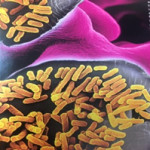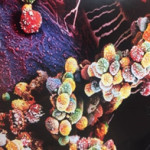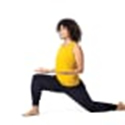Happy New Decade!
I read an article in this month’s National Geographic that I wanted to share with you. They have dubbed this the wellness issue. The article titled, The Microbiome Menagerie, gave me a lot to think about. It’s amazing that we have trillions of microbes living in and on our bodies. They are crucial to our health. Like cells that are constantly regenerating, these microbes can be healthy or unhealthy. Bacteria such as e-coli inhabit the human gut and perform essential functions, such as making vitamins K and B12 and repelling disease-causing bacteria. The bad strain of e-coli can cause food poisoning.

E-Coli

Strep

Microbes on Lip
Everyone’s mix of microbes are unique. Scientists are learning the man ways these microbes affect our health, weight, mood and even personalities. They are finding the surprising impact of these tiny organisms on how we look, act, think and feel. There are thought to be around 38 trillion microbes for a typical young male adult. That is slightly more than the number of human cells. We know that the cells in our bodies regenerate about every 7 years. We have constant opportunities for a positive impact on how those cells regenerate. This article states that our unique mix of microbes in our bodies is about the same as when we were very young. When a baby is born through the birth canal, he is greeted by all his mother’s bacteria from that area of her body. When a baby is born through a C-section, the bacteria from the mother’s abdomen and breasts attach to the baby. Studies found that a particular bacterium introduced from a vaginal birth gave babies a happier disposition in their early months. They have found that the c-section babies bacteria balances out by the end of the first year.
I find it fascinating that we can keep more healthy bacteria by what we put in and on our bodies. Bacteria lives on our skin, eyeballs, any place where the inside of our bodies meets the outside of our bodies with the largest concentration, about 90% living in our digestive tract. This is where the prebiotics (compounds that act as a substrate on which beneficial microbes can grow). Probiotics (the beneficial microbes themselves). Experiments are being conducted to transplant healthy bacteria in people with major health issues.
We truly do have gut instincts. Our bodies host trillions of microbes, bacteria, fungi, and protozoa that starts developing at birth and is unique to each of us. These microorganisms can communicate with our brains to regulate bodily functions and even influence our mood, as well as chronic conditions such as anxiety, through chemical communication pathways known as the gut-brain axis.
Foods to Live By
National Geographic, January, 2020 by Dan Buettner
There are 4 top areas on the planet that are known for having a high number of people living to 100. Experts have looked at different factors with diet being one distinguishable advantage to their longevity. The author calls these regions the blue zones. Traditional diets with whole grains, greens, nuts and beans offer the promise of eluding disease and staying healthy.
Okinawa, Japan-On Okinawa, as compared to the United States, residents are three times as likely to reach 100. Women suffer about half the rate of breast cancer, both sexes have a quarter of the rate of heart disease, and elderly people die from Alzheimer’s dementia at a tenth to a twelfth the rate. Their regular diet is mostly plant-based with foods that hare nutritionally dense and calorically poor, while in the U.S it is the reverse. Their foods are high in vitamins, antioxidants, calcium, magnesium and zinc. The minerals that are lacking in many American diets. Information is key to positive changes in our diets. This is a remarkable study that is helpful to everyone.
Sardinia, Italy-This island off the coast of Italy has the world’s highest concentration of male centenarians. Interestingly, it is a matriarchal culture in which women bear most of the family stress. A simple and traditional diet explain much of the longevity. A main meal in their diet is minestrone soup. It serves up essential amino acids, vitamins, and a range of fibers into unusually high levels of fatty acids. These saturated fats are associated with a lower risk of heart disease and may prevent cancer. Cruciferous vegetables, like cabbage and kohlrabi that find their way in almost every bowl of Sardinia minestrone may play a roll.
Nicoya, Costa Rica-People in this area have the longest life expectancy in the Americas. A healthy diet is just one part of this web of longevity. The Nicoya area is only about 30 miles long and consists of mostly dry pastureland and forests. People here supplement a corn and bean diet with tropical fruit, garden vegetables, and occasionally, wild game and fish. Black beans contain the same antioxidants found in blueberries. They are also rich in colon-cleansing fiber. The magic comes with paring corn with beans. Together they contain all of the amino acids we need without the unhealthy elements found in meat. Researchers have noted other factors like a sense of purpose, an environment that nudges one into constant movement, daily rituals that mitigate stress and having a circle of lifelong friends.
Loma Linda, CA-This community of Seventh-day Adventists, a Protestant denomination, bases their vegetarian diet from the bible. They tend to have a higher life expectancy than other Californians. A typical meal may not include grease, spices, salt or sugar. A meal might include a combination of black beans with steamed cabbage and cauliflower, with brown tofu, sesame seeds and a bit of soy sauce. This competes a satisfying mix of complex carbs, protein, vitamins, minerals, and antioxidants, with fewer calories than a bag of French fries.
Even though these Blue Zones are in different areas of the world, there are similarities. Those that incorporate meat into their diet eat it on average only five times a month. A plant-based diet with foods that are readily available. These simple mixtures that contain lots of vitamins, minerals, antioxidants and anti-inflammatory foods. As cancers and dementia plague our society, we have a wealth of information to make better choices every day. Bon Appetite!
Interested in learning more about Blue Zone diets? A new cookbook by Dan Buettner, The Blue Zone Kitchen, has tasty and nutritious recipes from areas with the highest percentage of healthy folks living to one hundred.
Trauma-informed Yoga
Start to feel safe and centered with practices that emphasize grounding and breathing.
by HALA KHOURI Yoga Journal Jan, 2020
In many yoga and healing circles, “trauma-informed” has become somewhat of a buzzword, referring to practices that are sensitive to the needs of—or specifically address the symptoms of—trauma survivors. The foundational intentions of a trauma-informed yoga practice are to help you find a sense of grounding and support in your body, to connect to sensations in a safe way, and to use the practice to help you trust your body’s signals again. This way, you can learn to self-regulate and find a sense of physical, emotional, and psychological safety, as well as presence and balance.
Trauma-informed methodology is less about specific poses or sequences and more about the focus of each pose and how it is inhabited. Ultimately, the practice’s cuing, pace, and sequencing are meant to help create a sense of support so that practitioners can feel sensations and emotions without being overwhelmed. I often say that it’s about learning to tolerate discomfort so that you can move through it rather than run away from it; unresolved trauma can leave you in a constant state of disconnection. Yoga can help free you from the grip of the past so that you can be truly present in an authentic and embodied way.
Traumatic events (car accidents, abuse, natural disasters, violence, death) can overwhelm your capacity to cope and respond. So can high levels of stress. Unresolved trauma affects overall mood regulation and physical health and can leave you feeling disconnected from your body. It can manifest as anxiety, depression, digestive issues, headaches, back pain, or autoimmune illnesses. Trauma can leave you feeling dissociated, where you don’t feel much at all, or highly activated, where you feel intense emotional or physical responses to certain stimuli. The effects vary from person to person, and there isn’t one type of yoga practice that works for everyone. That said, certain basic yoga tools can be helpful for almost anyone struggling with unresolved trauma or high stress.
Trauma-Informed Methodology: Feeling grounded, Centered & present in your body
Focus on the following in each pose: Feel the parts of your body that make contact with the ground, engage your core muscles to support your lower back (avoid gripping or trying to flatten your stomach), and breathe. When we breathe deeply, it can create a relaxation response in the nervous system. You want to feel that your breath is available to you rather than forced. Sometimes we don’t have access to a deep breath, and trying to force it isn’t helpful; in those cases, focus on grounding or centering.
Pay attention to how each pose feels during and afterward, and not just in your muscles and joints; notice if you feel calm, anxious, tired, or alert. You want to feel regulated, even in a vigorous pose. If a pose makes you feel anxious or overwhelmed, skip it or back off. Try the following sequence in any order that works for you. It doesn’t matter if you practice it leading with your right or left side; just be consistent. Eyes can be open or closed, whichever allows you to feel more present. This can change from moment to moment.
Here are the suggested steps with 3 to 4 breaths for each pose:
- Easy Pose

- Seated Side Stretch
- One-legged seated extension
- Savasana with bent knees
- Half Lotus
- Mountain
- Mountain variation (opening arms out on inhalation,9 rounding in on the exhalation)

- High Lunge
- Chair Pose
- Plank
- Cobra
- Table Top

- Kneeling Lunge
- Plank
- Down dog
- Warrior II
- Mountain
- Finish with Savasana on your side or stomach and RELAX

 Your New Favorite Protein Bar
Your New Favorite Protein Bar
Paleo Cacao-Coffee Protein Bars
2 cups nuts, such as almonds, pecans, cashews, or walnuts.
1 cup egg white powder
¼ cup cacao powder or unsweetened cocoa
3 Tbl espresso powder or instant coffee
18 large Medjool dates, pitted (about 10 oz)
Water if needed

Live in the World as it is but Work to Make the World as it Should Be.
Barak Obama


